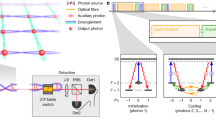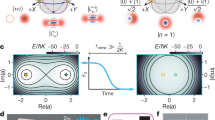Abstract
Schrödinger’s cat1 is a Gedankenexperiment in quantum physics, in which an atomic decay triggers the death of the cat. Because quantum physics allow atoms to remain in superpositions of states, the classical cat would then be simultaneously dead and alive. By analogy, a ‘cat’ state of freely propagating light can be defined as a quantum superposition of well separated quasi-classical states2,3—it is a classical light wave that simultaneously possesses two opposite phases. Such states play an important role in fundamental tests of quantum theory4,5,6,7 and in many quantum information processing tasks, including quantum computation8, quantum teleportation9,10 and precision measurements11. Recently, optical Schrödinger ‘kittens’ were prepared12,13,14; however, they are too small for most of the aforementioned applications and increasing their size is experimentally challenging. Here we demonstrate, theoretically and experimentally, a protocol that allows the generation of arbitrarily large squeezed Schrödinger cat states, using homodyne detection and photon number states as resources. We implemented this protocol with light pulses containing two photons, producing a squeezed Schrödinger cat state with a negative Wigner function. This state clearly exhibits several quantum phase-space interference fringes between the ‘dead’ and ‘alive’ components, and is large enough to become useful for quantum information processing and experimental tests of quantum theory.
This is a preview of subscription content, access via your institution
Access options
Subscribe to this journal
Receive 51 print issues and online access
$199.00 per year
only $3.90 per issue
Buy this article
- Purchase on Springer Link
- Instant access to full article PDF
Prices may be subject to local taxes which are calculated during checkout





Similar content being viewed by others
References
Schrödinger, E. Die gegenwärtige Situation in der Quantenmechanik. Naturwissenschaften 23, 807–812 (1935)
Yurke, B. & Stoler, D. Generating quantum mechanical superpositions of macroscopically distinguishable states via amplitude dispersion. Phys. Rev. Lett. 57, 13–16 (1986)
Schleich, W., Pernigo, M. & Kien, F. L. Nonclassical state from two pseudoclassical states. Phys. Rev. A 44, 2172–2187 (1991)
Sanders, B. C. Entangled coherent states. Phys. Rev. A 45, 6811–6815 (1992)
Wenger, J., Hafezi, M., Grosshans, F., Tualle-Brouri, R. & Grangier, P. Maximal violation of Bell inequalities using continuous-variable measurements. Phys. Rev. A 67, 012105 (2003)
Jeong, H., Son, W., Kim, M. S., Ahn, D. & Brukner, Č. Quantum nonlocality test for continuous-variable states with dichotomic observables. Phys. Rev. A 67, 012106 (2003)
Stobińska, M., Jeong, H. & Ralph, T. C. Violation of Bell’s inequality using classical measurements and nonlinear local operations. Phys. Rev. A 75, 052105 (2007)
Ralph, T. C. et al. Quantum computation with optical coherent states. Phys. Rev. A 68, 042319 (2003)
Van Enk, S. J. & Hirota, O. Entangled coherent states: Teleportation and decoherence. Phys. Rev. A 64, 022313 (2001)
Jeong, H., Kim, M. S. & Lee, J. Quantum-information processing for a coherent superposition state via a mixed entangled coherent channel. Phys. Rev. A 64, 052308 (2001)
Munro, W. J., Nemoto, K., Milburn, G. J. & Braunstein, S. L. Weak-force detection with superposed coherent states. Phys. Rev. A 66, 023819 (2002)
Ourjoumtsev, A., Tualle-Brouri, R., Laurat, J. & Grangier, P. Generating optical Schrödinger kittens for quantum information processing. Science 312, 83–86 (2006)
Neergaard-Nielsen, J. S., Nielsen, B. M., Hettich, C., Mølmer, K. & Polzik, E. S. Generation of a superposition of odd photon number states for quantum information networks. Phys. Rev. Lett. 97, 083604 (2006)
Wakui, K., Takahashi, H., Furusawa, A. & Sasaki, M. Controllable generation of highly nonclassical states from nearly pure squeezed vacua. Opt. Express 15, 3568–3574 (2007)
Schrödinger, E. Der stetige Uebergang von der Mikro- zur Makromechanik. Naturwissenschaften 14, 664–666 (1926)
Zurek, W. H., Habib, S. & Paz, J. P. Coherent states via decoherence. Phys. Rev. Lett. 70, 1187–1190 (1993)
Walls, D. F. & Milburn, G. J. Quantum Optics (Springer, Berlin, 1994)
Wigner, E. P. On the quantum correction for thermodynamic equilibrium. Phys. Rev. 40, 749–759 (1932)
Brune, M. et al. Observing the progressive decoherence of the “meter” in a quantum measurement. Phys. Rev. Lett. 77, 4887–4890 (1996)
Monroe, C., Meekhof, D. M., King, B. E. & Wineland, D. J. A. “Schrödinger cat” superposition state of an atom. Science 272, 1131–1135 (1996)
Lund, A. P., Jeong, H., Ralph, T. C. & Kim, M. S. Conditional production of superpositions of coherent states with inefficient photon detection. Phys. Rev. A 70, 020101(R) (2004)
Suzuki, S., Takeoka, M., Sasaki, M., Andersen, U. & Kannari, F. Practical purification scheme for decohered coherent-state superpositions via partial homodyne detection. Phys. Rev. A 73, 042304 (2006)
Serafini, A., De Siena, S., Illuminati, F. & Paris, M. G. A. Minimum decoherence cat-like states in Gaussian noisy channels. J. Opt. B 6, S591–S596 (2004)
Jeong, H. et al. Quantum-state engineering with continuous-variable postselection. Phys. Rev. A 74, 033813 (2006)
Yoshikawa, J. et al. Demonstration of a high-fidelity, deterministic and universal squeezing transformation. Preprint at 〈http://arxiv.org/quant-ph/0702049〉 (2007)
Ourjoumtsev, A., Tualle-Brouri, R. & Grangier, P. Quantum homodyne tomography of a two-photon number state. Phys. Rev. Lett. 96, 213601 (2006)
Waks, E., Diamanti, E. & Yamamoto, Y. Generation of photon number states. N. J. Phys. 8, 4 (2006)
Acknowledgements
This work was supported (in France) by the EU IST/FET project COVAQIAL and the ANR/PNANO project IRCOQ, and (in Australia) by the US Army Research Office and the DTO, the Australian Research Council and Queensland State Government. H.J. thanks T. C. Ralph and M. S. Kim for discussions.
Author information
Authors and Affiliations
Corresponding author
Ethics declarations
Competing interests
Reprints and permissions information is available at www.nature.com/reprints. The authors declare no competing financial interests.
Supplementary information
Supplementary Methods
This file contains Supplementary Methods which present a detailed theoretical analysis of the proposed protocol. After giving the general proof of principle, authors discuss the influence of its intrinsic limitations. Finally, an analytic model is presented which accounts for all the imperfections of the actual experiment. (PDF 240 kb)
Rights and permissions
About this article
Cite this article
Ourjoumtsev, A., Jeong, H., Tualle-Brouri, R. et al. Generation of optical ‘Schrödinger cats’ from photon number states. Nature 448, 784–786 (2007). https://doi.org/10.1038/nature06054
Received:
Accepted:
Published:
Issue Date:
DOI: https://doi.org/10.1038/nature06054
This article is cited by
-
A No-Go Result on Observing Quantum Superpositions
Foundations of Physics (2024)
-
Quantum secure direct communication with hybrid entanglement
Frontiers of Physics (2024)
-
Dissipative dynamics of optomagnonic nonclassical features via anti-Stokes optical pulses: squeezing, blockade, anti-correlation, and entanglement
Scientific Reports (2023)
-
Applications of single photons in quantum metrology, biology and the foundations of quantum physics
Nature Reviews Physics (2023)
-
Light emission from strongly driven many-body systems
Nature Physics (2023)
Comments
By submitting a comment you agree to abide by our Terms and Community Guidelines. If you find something abusive or that does not comply with our terms or guidelines please flag it as inappropriate.



